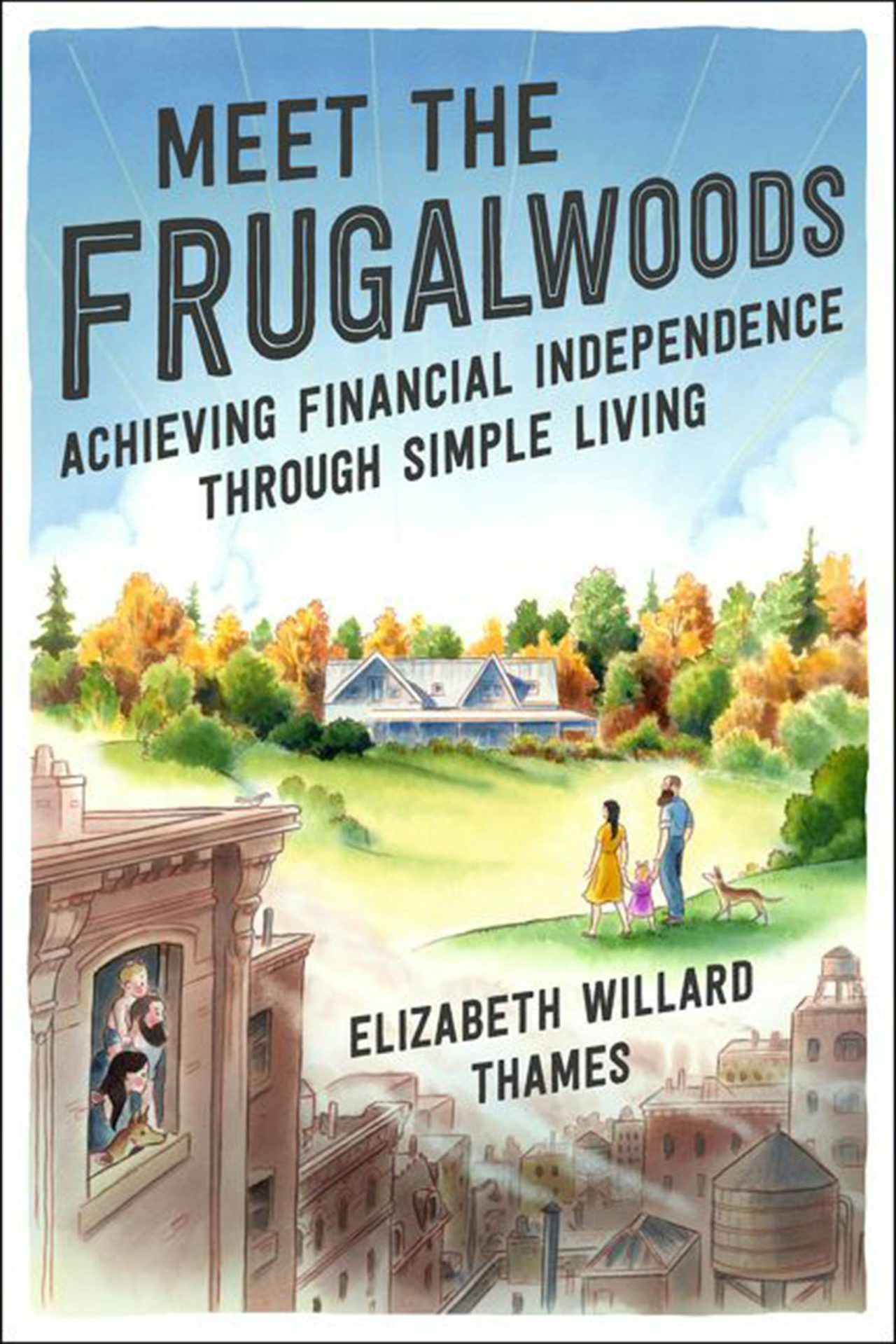What if buying a country house with its own apple orchard were as easy as giving up artisanal cheese and pre-sliced carrots for a while? What if you were able to retire in your thirties by simply living more “intentionally” and investing in low-fee index funds? If all that sounds peachy, then you’ve got to meet the Frugalwoods.
You might have read their story in The Guardian, but in any event, here’s the spiel. The Frugalwoods — real names Liz Willard Thames and Nate Thames — are a Millennial couple who did the nine-to-five non-profit thing in Cambridge, Massachusetts for several years before realizing they were trying to “buy their way into happiness” and deciding they had to break free. How? By retiring early, of course! So they squirreled away the majority of their income — in 2014, they saved an impressive 71 percent — cut back on things like eating out at restaurants and taking public transportation to work, and started a blog about their lives.
The Frugalwoods soon had enough money saved to escape their “frenzied” city grind. They bought a four-bedroom house in Vermont and began a leisurely new life on 66 acres of woods, streams, and apple trees. Within a few years, the Frugalwoods garnered a vocal audience of aspiring frugalists, a book deal with HarperCollins, and enough guest spots on money podcasts to catch the attention of NPR and The New York Times.
This month, Liz has published their story as Meet the Frugalwoods, which they’re spinning as an inspirational memoir for young readers looking to “regain control” of their lives by saving money and making smart investments. The book reveals various “hacks” the Frugalwoods employed to realize their dream of retiring to Vermont, such as giving each other haircuts, remodeling their kitchen themselves, and trawling Craigslist for furniture deals. It also covers the challenge of welcoming a baby to the mix, an addition the Frugalwoods claim has only cost them $75 each month (they recently had a second).
Their story slots neatly into a classist myth that millions of adults in this country still believe.
The most curious feature of the Frugalwoods’ saga is what’s missing from the narrative, and what gets magnified. Here’s one example: in the Guardian piece, which is culled from the book, Liz dedicates multiple paragraphs to describing how she and Nate started “insourcing” various household projects that might otherwise be farmed out to contractors, like painting their kitchen cabinets. What’s weird is the book’s assumption that hiring a cabinet painter is an expense that Millennials are liable to encounter — and that doing the job yourself is somehow empowering, innovative, and thrifty. Which leads to the Godzilla-sized question that overshadows so much of what the Frugalwoods write.
How much money do they have, and where does it come from?
The Frugalwoods are tight-lipped about their income, though back in 2012, before they moved to Vermont, the couple bought a $460,000 four-bedroom house in Cambridge, a short walk from MIT, according to their blog; last year, they rented it for a monthly rate of $4,400. They’ve also built a healthy investment portfolio. In 2014, Liz wrote that she and Nate both maxed out the $17,500 federal limit on 401K contributions, explaining that these didn’t factor into their annual percentage of saved income, which was already a whopping 71 percent.
But here’s the real kicker: the Frugalwoods have not actually retired in the traditional sense. A recent PBS NewsHour feature on the Frugalwoods clarified that Nate still works remotely for a political non-profit (hence the long and taxing search for a Vermont house with fiber optic Internet), while Liz writes and monetizes the blog. For that reason, she told PBS, she prefers to describe herself as “financially independent.”
So the Frugalwoods appear to be doing pretty well for themselves. And if their story carries a whiff of déjà vu, that’s probably because it slots neatly into a classist myth that millions of adults in this country still believe: the story of the American Millennial.
It goes like this. The 2008 recession may have cratered the wages and employment prospects for people just entering the job market, but according to the myth of the American Millennial, the real problem young people have today is themselves. Nearly a decade after the crash, the mainstream media still seems hell-bent on portraying people born between 1982 and 2004 as a bunch of decadent and “fun-employed” narcissists who piss their parents’ money away on matcha green tea lattes, spend too much time Instagramming their pets, and are thus responsible for the economic rut they’re stuck in.
This myth — which scrubs millions of underprivileged Millennials from the picture — is crucial to understanding why the media is swooning over the Frugalwoods right now. What’s remarkable about them is how they’ve managed to offer the public a kind of Millennial redemption story: a tale of two Millennials taking the time and responsibility to learn about money, rein in their spending impulses, and achieve financial security. But how realistic is that narrative?
Not very. Millennials have been caricatured as affluent liberal-arts majors with no career plans, but the reality is most Millennials don’t even have a college degree. And last year, the advocacy group Young Invincibles used Federal Reserve data to determine that Millennials as a whole earn about 20 percent less than Baby Boomers did during their formative years, and amass roughly half the net wealth.
The Bureau of Labor Statistics puts the median weekly income for Millennials with a high school diploma at $692, which amounts to barely $36,000 for a full-time annual salary. Meanwhile, the minority of Millennials with associate’s and bachelor’s degrees earn median weekly incomes of $819 and $1,156, which respectively add up to $42,588 and $60,112 annually. That’s before their paychecks are flattened by rent, utilities, and exorbitant health insurance premiums and deductibles. And for the millions of Millennial freelancers toiling away in the “gig economy” — which is growing larger each year — benefits like 401K plans and employer-paid insurance slide further out of reach.
Following the 2008 recession, a new kind of self-help guru — the Millennial frugality expert — emerged from the rubble.
Then, of course, there’s student loan debt. According to the Federal Reserve, Millennials in their twenties carried an average debt of $22,135 last summer. This is one of the most integral metrics of the Millennial experience because of its implications for how much money a young person can save. A recent study by ApartmentList claims that the rarefied minority of debt-free Millennials are putting away twice as much money as their counterparts who are still paying off balances. This makes it easier to put a down payment on a house, build a portfolio, and — if you’re lucky — retire early, Frugalwoods-style.
To be fair, the Frugalwoods aren’t the only ones preaching the gospel of salvation through penny-pinching, nor did they set the stage. The Western elite’s obsession with frugality stretches at least as far back as the inception of the Protestant Work Ethic: the popular idea that frugality is self-discipline and therefore something a virtuous person practices. Many of the modern rich are prolifically frugal, and for Americans who dream of a more gilded life, the art of bean counting can become its own form of religion.
When Warren Buffett talks about how he still takes his $3.00 breakfast at McDonalds, most Americans will interpret the anecdote in one of two ways. They’ll read it as a slice of humble pie — “That cuddly old billionaire hasn’t forgotten his roots” — or as a clue to be deciphered: “Maybe I’d be a billionaire too if I only spent $3.00 on breakfast.” The former endears us to the ruling class, and the latter conditions us to look at wealth-building as an exercise in personal improvement, as opposed to surviving — or, better yet, fixing — the structures and policies that keep most of us trapped in economic insolvency.
Following the 2008 recession, a new kind of self-help guru — the Millennial frugality expert — emerged from the rubble. Before the Frugalwoods, there was Broke Millennial, a self-described “financially independent” New Yorker whose parents covered half of her college tuition and began teaching her about building capital when she was seven years old. (She now imparts these lessons to her followers.) Another expert was the Millennial Money Man, a guy who dishes out “anti-entitlement advice” about growing your wealth. Not one for false modesty, he also keeps a live personal income report on the header of his blog. His January income was $155K.
What evangelists like these have embraced is a model of advice-giving that mostly involves telling self-congratulatory stories about how they achieved financial independence by being frugal. Sometimes the stories pander to Millennials by touching on issues like climate change — “Frugality is environmentalism!” — or the grim projections for Social Security and Medicare that Millennials should anticipate. But these stories are often missing the same pieces the Frugalwoods narrative lacks. Factors like above-average income (see: Millennial Money Man’s oft-mentioned “marketing business”) and access to capital and information (see: Broke Millennial’s oft-referenced “financially literate and savvy parents”) are often glossed over and not given the weight they deserve.
So who are these financial independence sermons for? Why are the Frugalwoods and their ilk broadcasting their life stories as practical advice for a generation that, on the whole, is just trying to stay afloat in the present, much less retire before 35? With the buzz around their first book, the Frugalwoods now have a unique opportunity to spread their philosophy to the masses. And yet, there’s a moment in their PBS special when Liz appears to concede that her advice might only be relevant for a lucky minority. “I am very aware that my frugality is elective and there’s so much privilege that goes into choosing your lifestyle whatever it is,” she says. “I think it’s very important for me to recognize that the way in which I experience frugality is not going to be the way in which everyone experiences it.”
But here’s the thing. Regardless of intent, these Millennials are telling an older generation of elite Americans — the very people whose policies and financial decisions kneecapped the economy — what they want to hear: that everything is more or less okay, and young people just need to be more thoughtful about their money. And that’s a shitty idea to perpetuate. Because whatever happens in the years ahead, penny-pinching will likely remain a lifestyle enhancement for bourgeois Millennials who possess enough money to enjoy the dividends of being thrifty. For most of us, there are no dividends: just thrift.

